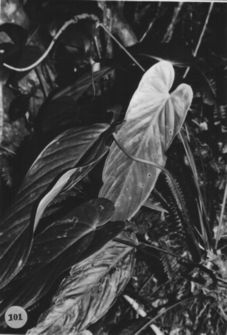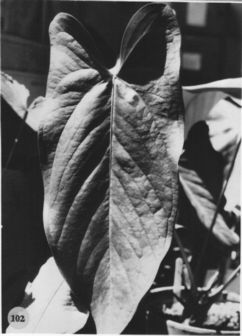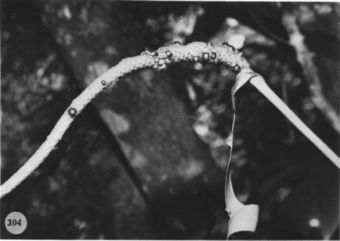






Anthurium longipeltatum Matuda,
Anales Inst. Biol. Univ. Nac. Mexico 37: 75, Fig. 1. 1967. TYPE: Mexico. Oaxaca: between Vista Her-mosa and Puerto Eligio, Comaltepec Ixtlan de Juarez, elev. 1,200 m in humid forest, October 5, 1963, MacDougall 563 (MEXU, holotype).
Epiphyte or terrestrial; stems green, ca. 18 cm long, 2.5-3 cm diam.; roots few, dark greenish-brown, descending; leaf scars 2-3 cm wide; cataphylls coriaceous, 6.5-15 cm long, long-acuminate at apex, drying dark brown, splitting at base, subpersistent.
LEAVES with petioles erect to spreading, 29-56 cm long, 5-7 mm diam., terete; geniculum 1-4.5 cm long; blades oblanceolate to oblong-ovate, moderately thick, long-acuminate at apex, lobed at base, 33-56 cm long, 14-28 cm wide, broadest just below middle; anterior lobe 34-40.5 cm long, the margins convex; posterior lobes 4.5-10 cm long; the sinus parabolic to triangular, sometimes the lobes overlapping, acute at apex; upper surface semiglossy to glossy, lower surface semiglossy, obscurely to conspicuously punctate; the midrib prominulous, convex above, more prominently raised below; basal veins 3-5 pairs, usually free, sunken or prominulous in valleys above, raised below; primary lateral veins 8-12 per side, departing midrib at 35°-50° angle, sunken above, raised below, arcuate-ascending to collective vein; lesser veins flat to weakly sunken above, flat below; collective vein arising from the first basal vein, sunken above, raised below, 5-10 mm from margin.
INFLORESCENCE erect-spreading, longer than leaves; peduncle 30-80 cm long, 3-8 mm diam., terete; spathe subcoriaceous, green sometimes faintly tinged purplish (B & K Yellow-green 8/10), oblong-lanceolate, 9-14.5 cm long, 1.5-2.2 cm wide, narrowly acuminate at apex, obtuse at base, inserted on peduncle at 30°-50° angle; spadix olive-green (B & K Yellow-green 6/5) to dark purple (B & K Blue-purple 2/10), 9-35 cm long, 7-9 mm diam. at base, 2-4 mm diam. at apex; flowers rhombic to 4-lobed, 2.5-4 mm long, 2.3-3 mm wide, the sides ± straight parallel to spiral, gradually sigmoid perpendicular to spiral; 6-7 flowers visible in the principal spiral, 7-9 flowers visible in the alternate spiral; tepals glossy, minutely papillate, sometimes with droplets as stamens emerge, lateral tepals 0.8-1 mm wide, the inner margin broadly rounded; pistils weakly emergent, green tinged with red-violet; stigma oblong-linear, 0.5-0.6 mm long, purplish with droplets apparent a few days before stamens emerge; stamens emerging from the base, the lateral stamens preceding alternates by 1 -2 spirals, exserted briefly on pinkish flattened filaments, which retract, holding stamens at edge of tepals against pistil; anthers pale yellow, held ± contiguous, 0.3-0.4 mm long, 0.5-0.6 mm wide; the-cae ellipsoid; pollen yellow to white, fading to cream.
INFRUCTESCENCE pendent, spathe withered; berries subglobose to obovoid, rounded at apex, red to red-orange (B & K Red 6/7.5), 8-8.5 mm long, 5.5-6.5 mm wide; mesocarp fleshy, ± transparent with raphide cells; seeds 1-2, ovoid, cream or greenish-white. 4 mm long, 2.5 mm wide, 2 mm thick with sticky appendages at both ends. Figs. 101, 102, and 104.
The species occurs in northern Oaxaca, Sierra de Juarez, Veracruz near
Orizaba, and is expected in nearby Puebia in Mexico in tropical wet forest
from 600 to 1,500 m elevation. The species is a member of section Belolonchium
and is distinguished by its moderately thick, deeply lobed, oblong-ovate
blades, which are dark green above and paler below, by its long slender
spadix, by having basal veins frequently free with little or no posterior
rib, and red to red-orange, subglobose berries.The collections of A.
longipeltatum from northern Oaxaca are somewhat obscurely punctate
whereas those collected near Valle Nacional are more conspicuously punctate.
The spadix color varies from olive-green to violet-purple. Anthurium
longipeltatum may be confused with A. verapazense,
a species ranging from Belize to Honduras, but that species has a consistently
violet-purple spadix and usually has a well developed posterior rib.Matuda
considered A. longipeltatum to be similar to A.
titanium (A. xanthosomifolium) but it is in no way similar or related
except that the two species have posterior lobes. Anthurium titanium
differs principally in lacking punctate dots on the lower blade surface.
The etymology of the name is curious. Although Matuda named the plant
"longipeltata" there is no part peltate. Perhaps this is a typographical
error from the intended "longipetiolatum."
 |
 |
 |
Map of Mesoamerican specimens with coordinates
Mexico Oaxaca: Mpo. Comaltepec, 1600 m, 17.37N 96.21W, 16 Apr. 1988,
Luna & Martín 249 (MO).
Mexico Oaxaca: 1430-1970 m, 17.37N 96.21W, 21 February 1987, Thomas
B. Croat and Dylan P. Hannon 65576 (MO).
Mexico Oaxaca: Sierra de Juarez, 1210 m,, 30 June 1977, Thomas B. Croat
39795 .
Mexico Oaxaca: 1210 m,, , Croat 39795 (MO).